 |
|
 |
| |
 |
|
[Math+Magic]™ Pro for Adobe InDesign
for Mac
|
MathMagic Pro v10.34 for InDesign (64-bit)
(for macOS 10.15 and newer including macOS 15 )
Date of Release: November 3, 2025
(Included Plug-ins)
New MathMagic CC 2026 Plug-in (v21)
MathMagic CC 2025 Plug-in (v20.1)
MathMagic CC 2024 Plug-in (v19.1)
MathMagic CC 2023 Plug-in (v18.1)
MathMagic CC 2022 Plug-in (v17.1)
MathMagic CC 2021 Plug-in (v16)
|
|
MathMagic Pro Edition v9.77 (32-bit)
(for Mac OS X 10.6 ~ macOS 10.14 Mojave)
Date of Release: November 28, 2022
(Included Plug-ins)
MathMagic CC 2021 Plug-in v16.0
MathMagic CC 2020 Plug-in v15.0
MathMagic CC 2019 Plug-in v14.0
Older versions may be available separately
If you are using macOS X 10.15 or newer, please use the 64-bit version.
If you are using macOS X 10.14 or older, please use the 32-bit version.
On macOS X 10.14, you can use both of the 32-bit version and the 64-bit version of v10.2x or older.
The 32-bit version may have a bit more features available.
The 64-bit version may offer you more modern user interface.
If you need to use MathMagic Pro with InDesign CC 2022 or newer,
please use the 64-bit version (v10.x).
If you need to use MathMagic Pro with InDesign CC 2021,
you may use the 32-bit (v9.7x) or the 64-bit version (v10.x, on Intel Mac).
If you need to use MathMagic Pro with InDesign CC 2020 or older,
please use the 32-bit version (v9.7x).
|
Thank you for choosing MathMagic,
the ultimate equation editor on the planet!
MathMagic Pro Edition for Adobe InDesign is an equation editor mainly for use with Adobe InDesign software in editing any mathematical expressions and symbols with WYSIWYG interface and various powerful features.
|
|
|
|
* Key Features
|
|
Click here to see the key features of MathMagic Pro Edition for Adobe InDesign.
|
(Click the following image to see the full sized.)
|
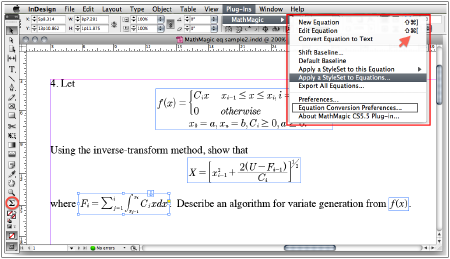
|
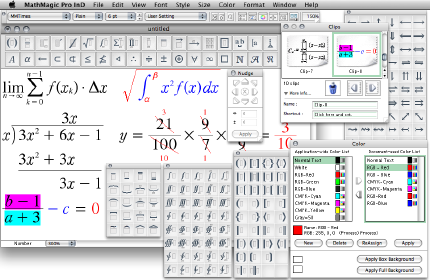
|
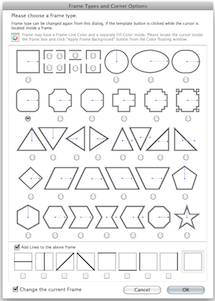
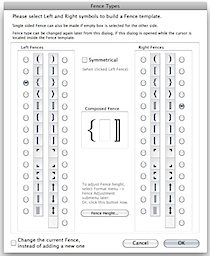
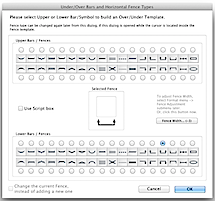
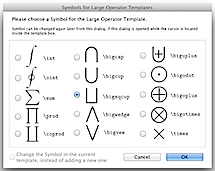

|
|
- Changed: Information for the current Cursor location is improved for the Equation Info and Character Info area on the right side of the Toolbar rows on top of each editor window.
- Fixed: When multiple MathMagic editor windows are opened, cascading did not work if the macOS Dock was turned on at the left side of the screen.
- Fixed: Ruler & Gridline Settings dialog did not maintain the Default Ruler Unit when "point (72)" or "point (100)" was selected for Horizontal and Vertical Rulers.
- * MathMagic CC2026 Plug-in(v21) for Adobe InDesign CC 2026. (MathMagic Pro only)
- Added: new "MathMagicCC2026.InDesignPlugin" added to support Adobe InDesign CC 2026 (v21).
|
|
- Added: Up arrow and Down arrow buttons right next to the Size popup menu in the Main Toolbar now support control-clicking or shift-clicking for increasing/decreasing by 0.1pt.
- Changed: Ruler interface improved for higher view rates.
- Fixed: Zoom-in / Zoom-out speed adjusted for the mouse scroll wheel when scrolling in an editor window while holding down option key or shift-option key.
- Fixed: Preferences -> Styles dialog: "Operators & Symbols" popup menu did not work.
- Fixed: View menu -> "Remember Last View rate" item did not work.
|
|
- Added: User-defined 'Clips' folders are supported.
- Changed: v10.32 works on macOS 10.15 or newer.
- Fixed: Old Clips were not displayed in the Clips window.
|
|
- Added: "Factory Settings" button added to the "Ruler & Gridlines Settings" dialog.
- Added: "Ruler & Gridlines Settings..." menu item added to the Contextual menu when the right-button clicked in the editor window.
- Changed: Ruler interface improved for a few ruler units and across the view rates.
- Fixed: UserItem Toolbar items were displayed incorrectly in some cases.
- Changed: Some UI and messages improved.
|
|
- Added: Horizontal Ruler and Vertical Ruler are supported via View -> Show Ruler & Gridlines submenu.
- Added: Horizontal Gridlines and Vertical Gridlines are supported via View -> Show Ruler & Gridlines submenu.
- Added: Ruler & Gridline settings are available via control-click or right-button click on the Ruler area.
- Added: Multiple Ruler units are supported: inch, cm, 72pt, 100pt, pica.
|
|
- Added: Color floating window now supports the listing options for colors by Added order, Name and Color Type.
- Added: Deleting all registered User Items from the UserItem Toolbar is supported by command-clicking on any empty area of the UserItem toolbar window.
- Changed: Factory setting values for Fraction line thickness and Sub-fraction line thickness have changed to slightly thicker lines.
- Fixed: Reordering the UserItem buttons unexpectedly deleted itself when drag & dropped onto the same item.
|
|
|
Please read Version History for the details.
|
|
|
|
|
|
| Please refer to the User Guide manual for the details: III. 8 Using MathMagic Plug-in in Adobe InDesign. |
|
|
1. Installing
- Please read the "Manual Install" document found in the downloaded disk image for the step by step instruction.
- Make sure that MathMagic
plug-in is manually installed in the following
location.
:Applications:Adobe InDesign CC:Plug-ins:
- Then, run MathMagic Pro application to let MathMagic finish the its own installation and setup, and leave it running.
- Then, run InDesign application, open PLug-ins -> MathMagic -> Preferences... dialog to adjust the default setting if desired.
- Now, it is ready to insert a New Equation in your InDesign document (in a Text box as an Inline Graphic object, or as a floating layer object).
2. Creating Equations
- Launch Adobe InDesign CC application.
- Make a new InDesign document
or open a document.
- Select the Plug-ins menu
-> MathMagic sub-menu.
- Choose "New Equation" item
to create an equation.
If the cursor is located in the text box,
the equation will be inserted in the cursor
position as an In-line Graphic(ILG). Otherwise,
the equation will be placed as an EPS
graphic on where you click the mouse.
- You may select the Sigma
tool button from the floating main toolbar
to create an equation box, and then drag
a rectangle in the document to specify
the location of an equation once created
by the external MathMagic Pro.
- You may also control-click(or
right button click) while the cursor is
in the text box, so that you can choose
the "New Equation" from the contextual
menu.
- If you either select "New
Equation" menu or drag a rectangle with
th Sigma tool, MathMagic Pro application
will be launched, if not running already,
and an empty equationd editor window will
be opened. In case MathMagic Pro application
is not launched automatically within a
few seconds, please launch the application
manually from the following location.
:Applications:MathMagic Pro Edition:
- Enter any equation in the MathMagic editor window, and then Close(cmd-W) or Save(cmd-S) the window. This will send the equation to the InDesign document back.
3. Editing Equations
- Choose "Edit Equation..."
item to edit the currently selected equation.
Or, just double-click on the equation
box to open it with the external MathMagic
Pro application for editing. You may also
control-click on the equation to bring
up the contextual menu, after changing
the cursor to the Arrow tool.
- After creating or editing
of equation with the external MathMagic
Pro, just close the equation editor window
so that the equation is placed in the
InDesign document.
4. Changing the Baseline and Bounding margins
- The baseline of all equations
will be automatically adjusted. But if
you want to lower or raise the baseline,
you may do so.
- just change the cursor
to the arrow cursor and move the equation
box by dragging to where you desire,
or
- control-click on the
equation box to bring up the contextual
menu, and then select "Shift Baseline"
item, or
- select an equation
box and choose "Shift Baseline" menu
from the MathMagic plug-in menu
- You may also customize the bounding margin gaps(left, right, top, bottom) of the equation, by specifying other value from the last item of Define Spacing window.
5. Applying a StyleSet to equations in InDesign document
- Right-button click on any equation and select "Apply StyleSet..." command from the contextual menu, or from MathMagic - Apply a StyleSet to this Equation command.
- Or, select one equation, or drag-select a range of text to include multiple equations, or select a Text box, then go to Plug-ins - MathMagic - Apply StyleSet command.
- Select one StyleSet from the list. Then, specify the scope to apply the StyleStyle: the selection equation, the current Text box, the current Page, or the whole document. Then, click "Apply".
- The maximum number to Apply a StyleSet is 100 equations at a time. If the selected range includes more than 100, please select smaller area and try again.
- If multiple equations are in the specified area, it may take a while to apply a StyleSet to all the equations in the scope.
- If no equation is found in the specified area, or if more than 100 equations, there will be an error message.
- After applying a StyleSet to all specified equations, there will be a Completion message with the total applied number of equations.
- If just one equation is selected, the completion message may not be displayed.
6. Assigning Shortcut keys to MathMagic menu items
- Install MathMagic plug-in by the instruction
- Launch InDesign application and make sure that MathMagic plug-in is loaded under Plug-Ins menu.
- Select Edit -> Keyboard Shortcuts... menu item from InDesign's menubar.
- In the "Keyboard Shortcuts" dialog, click "Product Area" popup menu, and select "MathMagic" item.
- Assign your preferred shortcut key, such as "cmd-shift-]" for "New Equation", "cmd-shift-[" for "Edit Equation".
|
|
| * System Requirements (64-bit) |
-
Intel Macintosh or Apple silicon Macintosh
- macOS 10.14 Mojave ~ macOS 15 Sequoia
- About 50MB of Hard disk space
-
Adobe InDesign CC 2021 ~ CC 2026
|
| * System Requirements (32-bit) |
-
Intel Macintosh
- Mac OS X 10.6 ~ macOS 10.14 Mojave
- About 60MB of Hard disk space
-
Adobe InDesign CS3, CS4, CS5, CS5.5, CS6, CC (Creative Cloud), CC 2014, CC 2015, CC 2017, CC 2018, CC 2019, CC 2020, CC 2021
-
(For Adobe InDesign CC 2022 or newer, please use MathMagic Pro v10.x)
|
|
|
| * Pricing |
- Free to Try
- Regular Perpetual License: US$499.00
- Academic Perpetual License: US$299.00
- 2-Month Subscription License: $100.00
- 6-Month Subscription License: $200.00
- Multi-user price available here
|
|
For the full pricing information, please
visit our online
store.
|
|
|
|
|
|
| * History of Older Versions |
|
|
|
|
|
[Math+Magic], MathMagic, MathMagic Personal Edition, MathMagic Pro Edition, MathMagic Prime Edition, MathMagic logo, InfoLogic and InfoLogic logo are trademarks or registered trademarks of InfoLogic, Inc.
iBooks Author, iWork, Pages, Keynote, AppleWorks, Mac OS X are trademarks or registered trademarks of Apple Inc.
MS Word, PowerPoint, Windows are trademarks or registered trademarks of Microsoft corp.
Adobe InDesign, Illustrator, Photoshop, Acrobat are trademarks or registered trademarks of Adobe Systems Inc.
QuarkXPress, QuarkXPress XTensions are trademarks or registered trademarks of Quark, Inc.
Other trademarks may be the properties of their respective owners.
|
|
|
 |
Copyright 1998-2025. InfoLogic, Inc. All rights reserved.
[ We proudly develop Quality software]SM
Contacts
|
|
|
| |
|
 |
 |